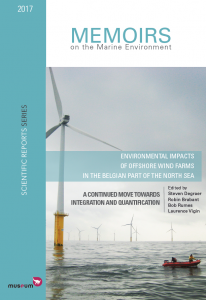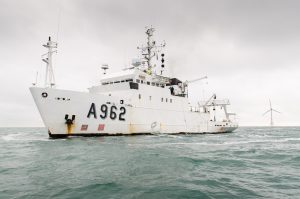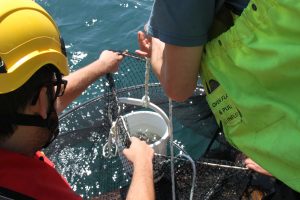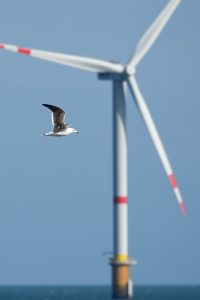To monitor the ecological impact of wind turbines at sea, our institute coordinates an extensive monitoring programme that detects the environmental effects. The programme is fully operational since 2008. A new report that describes the most recent results, has just become available.
As of 2016, 232 wind turbines are operational in the Belgian Part of the North Sea, with a total capacity of 870 Megawatt. To reach the national target of the production of 13% renewable electricity by 2020, the number of wind turbines in this area is planned to rise to 500. Together these will have a capacity of 2200 Megawatt, covering up to 10 % of the total electricity needs of Belgium. With 238 km² reserved for offshore wind farms in Belgian waters and 344 km² in the adjacent Dutch Borssele area, ecological impacts are inevitable.

The Royal Belgian Institute of Natural Sciences coordinates the monitoring, and specifically covers hydro-geomorphology, underwater noise, hard substrate invertebrates, radar detection of seabirds, marine mammals and socio-economic aspects. For soft substrate invertebrates, fish and seabirds, the programme relies on the additional expertise of Ghent University, the Institute for Agricultural and Fisheries Research (ILVO) and the Research Institute for Nature and Forest (INBO).
Due to the size of the area and the multitude of disciplines, comprehensive monitoring of the ecosystem in the wind farms remains challenging. The scientific follow-up focuses mainly on the disciplines that provide the most relevant information for the management. To safely differentiate between natural and anthropogenically induced variability, the programme is continuously being optimised.

Some remarkable results from the new report
Numbers, densities and biomass of invertebrates and fish living on or associated with the sea floor: the results indicate that the soft sediment ecosystem in between the turbines (at distances > 200 m) has not changed dramatically five to six years after construction, and that species assemblages within the offshore wind farms are mainly structured by temporal variability playing at larger spatial scales (e.g. temperature fluctuations, hydrodynamic changes, plankton blooms). However, plaice seems to be positively affected by the offshore wind farms. This could possibly be linked to locally increased food availability and/or the exclusion of fisheries inside the wind farms.
Biodiversity of natural hard substrates (e.g. gravel beds) versus artificial substrates (e.g. turbine foundations and scour protection): as natural hard substrates harbour a much higher species number and also more unique species than the artificial substrates, it seems that artificial hard substrates cannot act as equal alternatives for the loss of natural hard substrates.

Impact of underwater noise caused by pile driving activities on fish and marine mammals: in a field experiment with caged cod, the scientists detected a steep increase in swim bladder injuries with decreasing distance from the sound source. Additionally, many internal bleedings and a high degree of abnormal swimming behaviour were observed after piling, all hints for a reduced survival rate in the long term. With the current sound limits applicable to Belgian waters, negative effects of this type of underwater noise can occur in fish within a radius of 750 m from the pile driving location. During piling, harbour porpoise detections decreased by up to 75% up to 20 kilometre from the location of the piling event. Simultaneously, porpoise detections nearly doubled at larger distances, which may be due to active attempts of these animals to escape from the underwater noise.

Presence and behaviour of birds: Four species were shown to avoid the wind farm on the Thornton-bank (northern gannet, little gull, black-legged kittiwake and common guillemot), while three others (great black-backed gull, herring gull and sandwich tern) proved to be attracted. When zooming into the behaviour of some species, a continued study of the observed shifts (e.g. decrease of the time spent flying, foraging on fauna growing on the foundations) may shed a new light onto the anticipated collision risk of large gulls with wind turbines. Besides seabirds, also large numbers of non-seabirds are known to migrate at sea. As the victims disappear in the water and cannot be counted, a bird radar is used to unravel the migration patterns. In the future, the recorded bird fluxes will be analysed with an explanatory model, and the collision potential will also be estimated for such birds.
